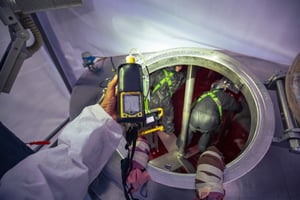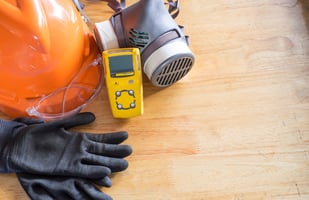When it comes to handling and monitoring flammable gases, safety is of paramount importance....
Understanding Gas Measurement Units: %LEL, %VOL, and PPM in Flammable and Toxic Gas Detection
When it comes to measuring flammable and toxic gases, three common units are frequently encountered: %LEL, %VOL, and parts per million (ppm). Each of these units provides valuable information about gas concentrations, but they serve different purposes and have distinct characteristics. In this blog post, we'll explore the differences between these units, their applications, and how they relate to both flammability and toxicity concerns.
Lower Explosive Limit (%LEL)
The Lower Explosive Limit (LEL) is a crucial safety parameter for flammable gases. It represents the minimum concentration of a gas in air that can ignite or explode when exposed to an ignition source. %LEL is expressed as a percentage of this lower explosive limit.
For methanol, the LEL is typically set at 6% by volume in air. This means that when methanol reaches a concentration of 6% in air, it becomes potentially explosive. Using %LEL allows safety professionals to gauge how close the gas concentration is to this dangerous threshold.
Example:
- 100% LEL of methanol = 6% VOL
- 50% LEL of methanol = 3% VOL
- 10% LEL of methanol = 0.6% VOL
Safety alarms are often set at lower levels, such as 10% or 20% LEL, to provide an early warning before reaching dangerous concentrations.
Volume Percent (%VOL)
Percent by volume (%VOL) directly measures the amount of gas present in the air. It represents the volume of gas per 100 units of air. This unit is particularly useful for measuring higher concentrations of gases, especially when approaching or exceeding the LEL.
Example:
- 6% VOL of methanol = 100% LEL
- 3% VOL of methanol = 50% LEL
- 12% VOL of methanol = 200% LEL (above the explosive limit)
%VOL provides a straightforward measure of gas concentration, making it valuable for various applications beyond just safety considerations.
Parts Per Million (PPM)
Parts per million (ppm) is used to measure very small concentrations of gases. One ppm represents one part of gas per million parts of air. This unit is particularly useful for detecting trace amounts of gases or when high precision is required, especially when dealing with toxic gases.
Converting %VOL to PPM
To convert %VOL to ppm, we can use a simple conversion:
0.1% VOL = 1000 ppm
This relationship allows us to easily move between these units by shifting the decimal point four places. For example:
- 1% VOL = 10,000 ppm
- 0.01% VOL = 100 ppm
- 0.001% VOL = 10 ppm
Toxicity Considerations: The Case of Methanol
While %LEL is crucial for assessing flammability risks, ppm measurements are often more relevant when considering the toxicity of gases like methanol. Methanol is not only flammable but also highly toxic, making it essential to monitor both its flammability and toxicity levels.
UK Workplace Exposure Limits for Methanol
According to the UK's EH40 workplace exposure limits:
- Short-term exposure limit (STEL): 250 ppm
- Long-term exposure limit (LTEL): 200 ppm
These limits are set to protect workers from the harmful effects of methanol exposure. It's important to note that these toxicity-based limits are much lower than the flammability-based LEL (6% VOL or 60,000 ppm).
Importance of Dual Monitoring in Confined Spaces
When working in confined spaces, it's crucial to monitor both the flammability and toxicity of hazardous gases like methanol. Here's why:
1. Flammability Risk: Monitoring %LEL ensures that the gas concentration doesn't approach explosive levels. For methanol, an alarm might be set at 10% LEL (0.6% VOL or 6,000 ppm, much higher than the workplace exposure limits) to warn workers well before reaching dangerous levels.
2. Toxicity Risk: Even at concentrations well below the LEL, methanol can pose serious health risks. The workplace exposure limits (200-250 ppm) are much lower than the LEL, indicating that toxic effects can occur at concentrations that aren't a flammability concern.
3. Comprehensive Safety: By monitoring both %LEL and ppm levels, workers can be protected from both immediate explosion risks and long-term health effects.
4. Rapid Response: Different sensors may be more sensitive to changes in concentration at different ranges. Using both %LEL and ppm measurements allows for quicker detection of changing conditions.
5. Regulatory Compliance: Many safety regulations require monitoring of both flammability and toxicity in hazardous environments.
Practical Applications
Understanding these units and their relationships is crucial in various industries:
1. Industrial Hygiene: ppm measurements are essential for assessing worker exposure to toxic gases like methanol over time.
2. Emergency Response: First responders need to quickly assess both explosion risks (%LEL) and potential toxic exposures (ppm) when dealing with chemical spills or leaks.
3. Process Safety: In chemical manufacturing, both %LEL and ppm measurements may be used to ensure safe operating conditions and product quality.
4. Environmental Monitoring: ppm measurements are often used to detect low-level emissions of volatile organic compounds (VOCs) like methanol in ambient air.
Conclusion
While %LEL, %VOL, and ppm all measure gas concentrations, they serve different purposes and are used in various contexts. %LEL focuses on safety and flammability risk, %VOL provides a direct measure of gas volume, and ppm allows for precise measurements of trace amounts, particularly important for toxicity concerns.
When dealing with gases like methanol that pose both flammability and toxicity risks, it's essential to use a combination of these measurements. By understanding these units, their relationships, and their specific applications, professionals can effectively monitor and manage gas concentrations in a wide range of scenarios, ensuring both short-term safety and long-term health protection in hazardous environments.








